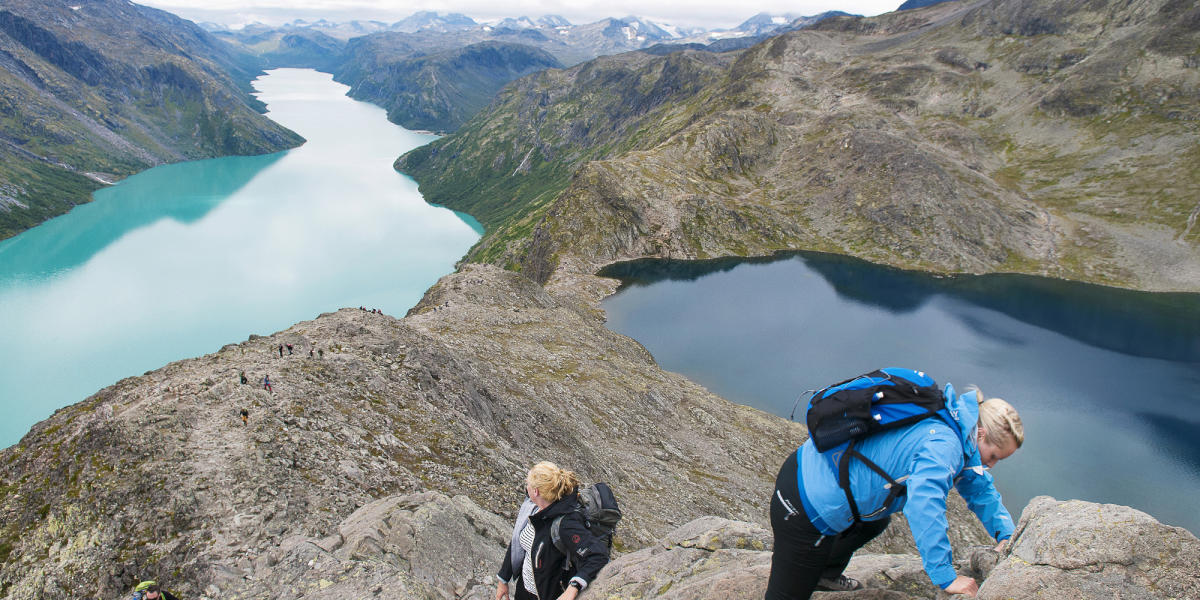 Monumental nature in the mountain kingdom of Norway is captivating with its high peaks, steep gaps, the endless plains, deep forests and fertile valleys with wild rivers. Almost a third of Norway is mountains. Most of the mountains are located in the southern part of the country, where they form the "backbone" between the wealth of fjords facing the west, and vast forests and golden farmland landscape towards Sweden in the east. Trolls live in these mountains.
Monumental nature in the mountain kingdom of Norway is captivating with its high peaks, steep gaps, the endless plains, deep forests and fertile valleys with wild rivers. Almost a third of Norway is mountains. Most of the mountains are located in the southern part of the country, where they form the "backbone" between the wealth of fjords facing the west, and vast forests and golden farmland landscape towards Sweden in the east. Trolls live in these mountains.
Norwegians have a close and active attitude to unspoiled nature in the mountains, both in summer and winter.
In Jotunheimen you can go hiking or rafting on the rushing rivers flowing through the valleys. Or maybe an expedition to the glacier, skiing in the middle of summer? Hiking on marked alpine trails, open plateaus or secluded forests are perfect for this, who is looking for peace and quiet.
Olympic cities with 1994 roku -Lillehammer, Gjoviki Hamar – they lie around the largest lake in the country, Mjosa. They are great starting points, from where you can get acquainted with the Norwegian mountain kingdom, including Trollheimen, Dovrefjell and Rondane in the north, and also with the mighty Jotunheimen and the vast Hardangervidda plateau further south. Long and beautiful river valleys, jak Hallingdal, Valdres, Gudbrandsdalen in 0sterdalen, they lead up and down into the monumental kingdom of the mountains.
The mountains and valleys hide many cultural treasures, for example the mining village of Roros, with unique wooden buildings, and the characteristic stave churches in the valleys, decorated with the folk norwegian rosemaling style.
Norway's oldest sidewall, Skibladner, swims on Lake Mjosa in summer and takes you on a route between Lillehammer, Gjovik in Hamar, where can you, among others, visit the mines of Hamardomen Cathedral. In Lillehammer, you can be impressed by the old woman, Norwegian peasant architecture at the Maihaugen Museum. Or maybe a visit to the cradle of ski sports in Telemark? Here, too, you can start an extraordinary cruise on the Telemarkskanalen canal, which will lead you to the sea, on the South Norwegian coast.
Skibladner z 1856 year is Norway's only steam sidecar and still operates on Norway's largest lake.
Hamardomen is a building protecting the ruins of the old cathedral from approx. XIII century. The ruins were glazed in 1998 year, to protect against frost and moisture.
The Maihaugen Museum contains an impressive collection of old buildings taken from Lillehammer or the nearby valleys.
Goats are a permanent feature of the mountains. By brewing goat's milk, a typically Norwegian geitosten cheese is obtained.
In the wilderness of Dovrefjell, you can go on a musk ox safari.
Church of Roros, with a characteristic tower, lies in the city center.
The traditional Rorosmartnan market has been held every year since 1854 and lasts five days.
Roros is lying 600 meters above sea level. The cornerstone of the Roros society was the copper mining activity of Roros Kobberverk and for this reason it is called a mining settlement. There are many historical monuments in the area, and the entire Mining Village is inscribed on the UNESCO cultural heritage list.
Gaustatoppen is lying 1883 m n.p.m. and is one of the best viewpoints in the country. In good weather, the view covers one-sixth of mainland Norway.
Beautiful silver decorations are an obvious addition to bunads. Woodcuts are part of a rich handicraft tradition in Norway.
The interior of the Heddalstavkirke painted in the traditional rosemaling style. About 1,000 stave churches were built in Norway during the Middle Ages. Today only remains 28 of these impressive and completely unique wooden churches. The largest of them all is the Heddalstavkirke in Telemark.
Hardangervidda is the largest plateau in Northern Europe and the largest of Norway's many national parks.
500 people it took five years, to dig the Telemarkskanalen canal with dynamite, which runs from the foot of the Hardangervidda all the way to the coast, to the city of Skien. The channel was ready in 1892 year, and was the greatest engineering achievement of the time.
